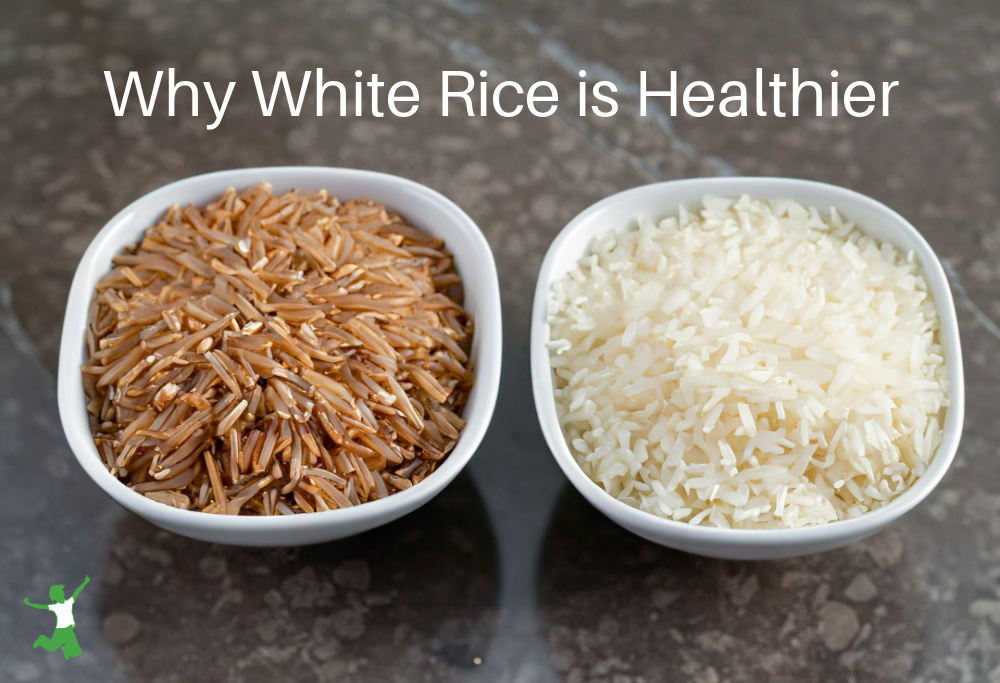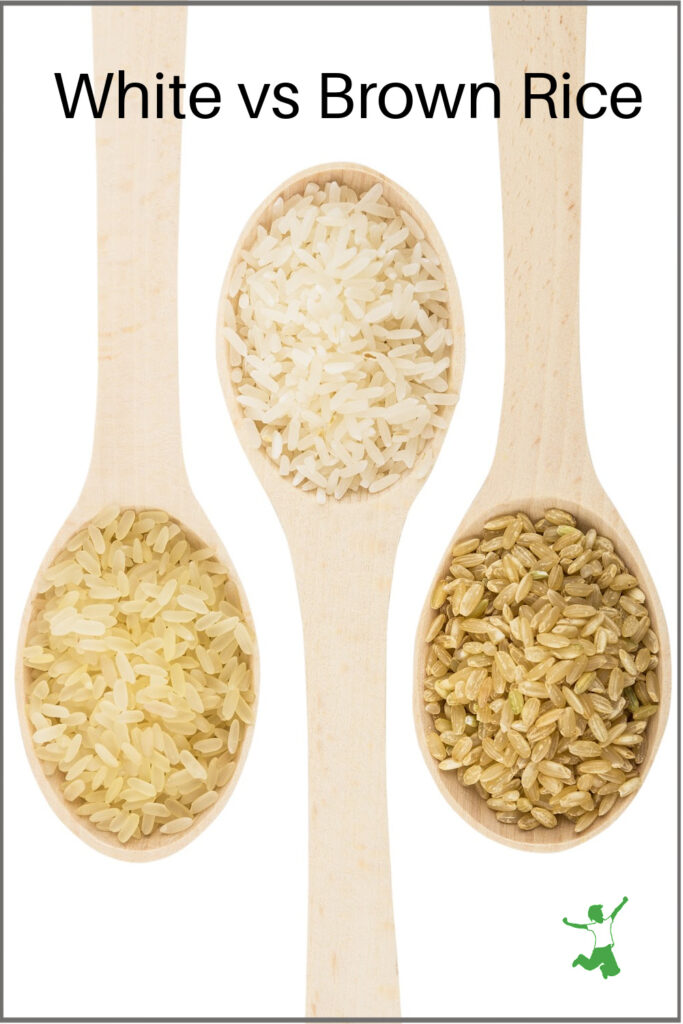The reasons white rice is healthier than brown rice as determined by research as well as which type traditional societies preferred consuming.

My article and video on healthy Chinese food drew some comments from readers who questioned my choice of rice.
Why was I using white rice vs brown? Isn’t brown rice the healthier choice, after all?
Ok, I’ll spill the beans, rice. Here are my reasons …
The truth is, neither my husband nor myself have ever enjoyed brown rice (although we love the nutty flavor and digestibility of wild rice).
Every time we eat brown, it just seems to not sit very well in our stomachs.
Even when it is sprouted or soaked before cooking, it, well, uh, sits like a brick for lack of a better word.
Why Some People Should Eat White Rice
White rice just seems to digest a whole lot better for us. That to me was reason enough to choose it over the brown rice.
We were also advised by an Ayurvedic MD back in the 1990s to stick with white basmati rice. This recommendation clinched the decision.
You are what you digest, after all – not necessarily what you eat!
End of story? Well, not quite.
Rice Fiber in Brown Harms a Compromised Gut
A few years back at the annual Wise Traditions Conference, I became familiar with a compelling book called Fiber Menace.
The author writes extensively about the dangers of a high-fiber diet as it pertains to a menu loaded with whole grains as pushed by the misguided Food Pyramid.
In other words, folks who eat a bowl of All Bran every morning to keep the bathroom visits regular are unknowingly ripping their insides to shreds.
The basic premise of Fiber Menace is that grain fiber plays a leading role in many gut-related ailments including colon cancer.
When I first learned of this information, my preference for white rice over brown rice started to make more sense.
Perhaps the brown rice didn’t digest that well because of all that fiber?
Chalk one up for the white rice.
White Rice Far Lower in Phytic Acid
A second piece of information came from author Ramiel Nagel.
In his book, Cure Tooth Decay, he writes about the devastating effects of phytic acid in the diet. Phytic acid is a very powerful antinutrient and blocker of mineral absorption in the gut.
Mr. Nagel identifies brown rice as very high in phytic acid.
What’s more, soaking brown rice does not reduce phytic acid by much at all!
Polished Rice is the Ancestral Form
Ramiel also maintains that the traditional method for preparing brown rice is never to eat it whole (with only the husk removed).
Rather, ancestral societies pounded brown rice in a mortar and pestle to polish it by removing the outer bran layer. This is the primary source of the phytic acid.
Nagel goes on to point out that experiments have shown that the milled and polished rice that results from this pounding process, has the highest mineral absorption.
In short, mineral absorption from whole brown rice is much less than white polished rice. This is because the phytic acid in the bran which is not reduced much by soaking, greatly interferes with the absorption process.
What About Arsenic?
A big issue with arsenic contamination in rice has emerged in recent years. Some folks have responded by no longer eating rice at all.
This is an overreaction, in my view.
Clean rice is definitely available if you know what to look for.
This article on how to avoid arsenic in rice details what to do. While soaking brown rice barely moves the needle on phytic acid, soaking white rice before cooking removes nearly all the arsenic!
Another option is to parboil white rice before using fresh water for a full cook if you don’t have time to soak.
Is White Rice Better Than Brown?
So it seems that brown rice is not necessarily a healthier choice than milled white rice.
Black or red rice would fall into the same category.
Obviously, whether you choose one or the other is a personal preference, but I hope this information helps you sort through the decision with a bit more clarity.
As for me and my family, we will be sticking with white basmati and jasmine rice (white basmati rice is more nutritious than plain white rice).
I currently buy this brand of rice in 25-pound bags as the most economical and high-quality choice.
Observation clued me in many years ago that brown rice was not something that was sitting well in my stomach or my husband’s.
As the years go by, more research is coming forth to indicate that this decision was the right way to go after all.
Do you eat white rice or brown rice in your home? Why or why not?

References
(1) Fiber Menace
(2) Living with Phytic Acid
More Information
Macrobiotic Diet and Extreme Vitamin D Deficiency
Tiny Teff Grains Deliver Big on Nutrition
How to Make Perfect Yellow Rice (Arroz Amarillo)
Millet: Healthy or Not?
Do Whole Grains Cause Cavities?






I was taught to wash the brown rice by soaking in water and "scrubbing" it with my hands, rinsing and repeating until the water stayed fairly clear. This would "polish" the rice and removed a significant portion of the bran.
My nutritionist would agree that there is little nutritional difference in white rice or brown rice grown and processed in a similar way. If they start selling GMO rice…that's a whole new ball game.
Hi Ashley Jane, pasta is not the greatest food by a long shot. We only have it on rare occasions in our home. Unless you sprout your grain and then make the pasta yourself, I don't see it as anything but a hard to digest, improperly prepared grain filler food at best. Couscous is not soaked or sprouted either so would be in the same category as pasta. Whole wheat pasta would be just as bad as refined IMO – probably worse as the phytic acid in the bran would block what few minerals could be digested anyway. Quinoa is fine as long as it is soaked or sprouted first. I am not a big fan of grains anyway and when you do eat them, great care must be taken in their preparation.
Quinoa is not a grain. It is a seed.
A grain is a type of seed. For example, the kernels of corn are seeds but they are also a grain.
A grain is a type of seed, true–but not all seeds are grains. Quinoa is a seed that is not a grain.
Hi Paula, according to Nourishing Traditions Cookbook, quinoa is indeed a grain (p. 475) full of antinutrients like other grains and as such requires special preparation such as sprouted or soaking before eating.
In my switch to traditional foods I find the whole grain/properly prepared grains and rices to be the most difficult thing to understand. The WAPF website is a bit difficult to navigate to find information on what to eat in these areas. For instance, is all pasta bad? Is whole what pasta worse than refined? What about things like quinoa and couscous?
We eat both. I prefer brown (taste, texture, and GI wise) and my husband prefers white. I use white for recipes such as Spanish rice, when brown rice just isn't right, and if we're having plain rice as a side dish, because I think it's more flavorful and I get Gestational Diabetes (and I'm often pregnant) meaning I must watch how much fiber/protein/carbs I consume and in what ratios. But we'll have white rice with stirfries or mixed into other things.
I'm not a huge grain eater, one way or the other, but when I eat rice, I prefer white. I know that I've taken a little heat for this from the health food police and felt mildly ashamed, but brown rice just never tasted very good to me. Thought-provoking post, thank you!
Thanks so much for writing this post! I like the taste of brown rice, but I usually prefer white rice, especially for fried rice. I know brown rice is usually recommended, however, in India I believe rice is traditionally milled first, which would indicate the rice bran is not as good for you.
It is definitely food for thought, but this makes me feel a lot better about serving white rice to my family 🙂
hi sarah, thanks for another great post. I am a retired chef in NYC (20 year veteran), cooking instructor and stay at home mom to two young children – 2 & 5 years. Fried rice is an economical, quick pick-up, delicious treat in our house as well. i wanted to share some of our family recipe ideas for fried rice that i feel would bring the dish to another level. 1. After you've added the coconut oil to the pan, add fresh garlic and ginger – then the egg, then the rice. (you can also add crispy almonds and chiles for texture and heat 2. adding veggies like shredded carrot, thinly cabbage and broc will impart a sweetness. 3. add any protein – fish, pork, beef, chicken, etc 4. finish with an "asian sauce" that can be used as a sauce, marinade or vinaigrette. keep this sauce in a clearly marked plastic squeeze bottle in the fridge for easy use. A balanced blend of fermented shoyu, fish sauce, rice wine vinegar and fresh lime juice. when you want to use it as a vinaigrette, gently heat coconut oil and emulsify. 5. When all is cooked through and rice has taken on the sauce. turn off the heat and add scallion, fresh cilantro and thai basil (regular basil will do). an extra squeeze of lime juice is always nice when serving. thanks again for all the info. i look forward to reading your posts on a daily basis. be well and enjoy!
Hi Sarah,
How is white Jasmine rice more nutritious than plain white rice?
We eat brown rice, but I now use the method that Rami described in the article, the one that Katie mentions in her comment above. I also cook it in bone broth and serve with lots of butter.
It is interesting though. I worked with 2 girls, one from the Middle East, and one from the Phillipines. They both told me that back home, it was traditional practice to pound the rice and feed the bran to the pigs. They also did not soak their rice. Nowadays, they just buy white rice.
My dd has cavities, and we have to be careful of grains. I have consulted with Rami, and it is his suggestion that I freshly grind my grains, and then sift and large portion of the bran out to further remove phytates.
Ah, you've touched a great point for this white rice loving family! We enjoy a good side of white rice and I genuinely feel that it is not damaging to our health in any way. Traditional cultures did sometimes remove some of the hull when they ate their grains. There's no reason to think we can't do the same. Brown rice never worked for our family, and using white has been much easier and more enjoyable.
Sarah! Wonderful post and I want to share it on my Thoughts of Friday blog post! What I love even more than the information you discovered about the white rice is that YOU were eating Intuitively which is something I have been doing and trying to explain to people for a very long time! LOVE IT! 🙂 Alex@amoderatelife